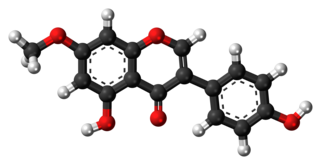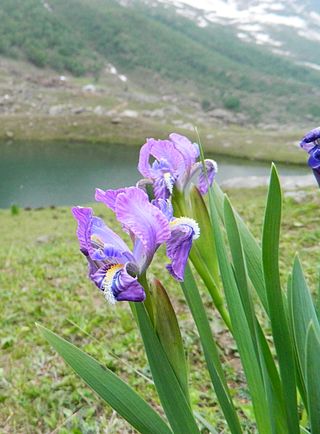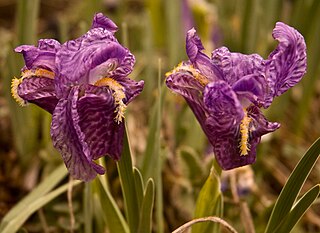Isoflavones are substituted derivatives of isoflavone, a type of naturally occurring isoflavonoids, many of which act as phytoestrogens in mammals. Isoflavones are produced almost exclusively by the members of the bean family, Fabaceae (Leguminosae).

Genistein (C15H10O5) is a naturally occurring compound that structurally belongs to a class of compounds known as isoflavones. It is described as an angiogenesis inhibitor and a phytoestrogen.

Daidzein is a naturally occurring compound found exclusively in soybeans and other legumes and structurally belongs to a class of compounds known as isoflavones. Daidzein and other isoflavones are produced in plants through the phenylpropanoid pathway of secondary metabolism and are used as signal carriers, and defense responses to pathogenic attacks. In humans, recent research has shown the viability of using daidzein in medicine for menopausal relief, osteoporosis, blood cholesterol, and lowering the risk of some hormone-related cancers, and heart disease. Despite the known health benefits, the use of both puerarin and daidzein is limited by their poor bioavailability and low water solubility.

Iris × germanica is the accepted name for a species of flowering plants in the family Iridaceae commonly known as the bearded iris or the German bearded iris. It is one of a group of hybrid origin. Varieties include I. × g. var. florentina.

Biochanin A is an O-methylated isoflavone. It is a natural organic compound in the class of phytochemicals known as flavonoids. Biochanin A can be found in red clover in soy, in alfalfa sprouts, in peanuts, in chickpea and in other legumes.

Irigenin is an O-methylated isoflavone, a type of flavonoid. It can be isolated from the rhizomes of the leopard lily, and Iris kemaonensis.

Tectorigenin is an O-methylated isoflavone, a type of flavonoid. It can be isolated from leopard lily, in Iris unguicularis or Pueraria thunbergiana.

ψ-Tectorigenin is an O-methylated isoflavone, a type of flavonoid. It can be isolated from Belamcanda chinensis, Dalbergia sissoo. It can also be isolated from the bacterium Nocardiopsis sp, and from the mold Stemphilium sp. No. 644.
The O-methylated flavonoids or methoxyflavonoids are flavonoids with methylations on hydroxyl groups. O-methylation has an effect on the solubility of flavonoids.

Prenylated flavonoids or prenylflavonoids are a sub-class of flavonoids. They are widely distributed throughout the plant kingdom. Some are known to have phytoestrogenic or antioxidant properties. They are given in the list of adaptogens in herbalism. Chemically they have a prenyl group attached to their flavonoid backbone. It is usually assumed that the addition of hydrophobic prenyl groups facilitate attachment to cell membranes. Prenylation may increase the potential activity of its original flavonoid.

Retusin is an O-methylated isoflavone, a type of flavonoid. It can be found in Fabaceae species like Dipteryx odorata, in Dalbergia retusa and in Millettia nitida. It can also be found in Maackia amurensis cell cultures.

Irilone is an isoflavone, a type of flavonoid. It can be found in Trifolium pratense, in Iris unguicularis and in Iris germanica.

Prunetin is an O-methylated isoflavone, a type of flavonoid. It has been isolated for the first time by Finnemore in 1910 in the bark of Prunus emarginata. Prunetin isolated from pea roots can act as an attractant for Aphanomyces euteiches zoospores. It is also an allosteric inhibitor of human liver aldehyde dehydrogenase.

Iris milesii is a plant species in the genus Iris, subgenus Limniris and in the section Lophiris. It is a rhizomatous, beardless perennial plant, native to the Himalayas, India and China. It has pinkish-violet, or pinkish purple, or pinkish-lavender or pinkish lilac flowers, with a fringed yellow or orange crest. It is cultivated as an ornamental plant in temperate regions.
Iris songarica is a beardless iris in the genus Iris, in the subgenus Limniris and in the series Tenuifoliae of the genus. It is a rhizomatous herbaceous perennial, from Central Asia, located in Afghanistan, Pakistan, Iran, Kazakhstan, Tajikistan, Turkmenistan and Uzbekistan. It has long strap-like leaves, a long stem and 2–3 flowers in shades of violet, dark blue, to lavender blue.
Iris crocea is a species in the genus Iris, it is also in the subgenus Limniris and the series Spuriae. It is a rhizomatous perennial plant, found in Kashmir. It is cultivated as an ornamental plant. It is also commonly known as Golden Iris or Golden Flag. It was also known as Iris aurea for a long time, before that was regarded as a synonym of Iris crocea.

Iris hookeriana is a plant species in the genus Iris, it is also in the subgenus Iris and in the section Pseudoregelia. It is a rhizomatous perennial, from the Himalayan mountains of India and Pakistan. It has long pale green or yellow green leaves, long slender stem and fragrant blue, purple or lilac flowers, that are mottled with a darker colour. It is cultivated as an ornamental plant in temperate regions.

Iris kemaonensis, the Kumaon iris, is a plant species in the genus Iris, it is also in the subgenus Iris and in the section Pseudoregelia. It is a rhizomatous perennial, from Tibetan China, Bhutan, India, Kashmir and Nepal. It has light green or yellowish green leaves, that extend after flowering time. It has a short stem, 1–2 fragrant flowers that are purple, lilac, lilac-purple or pale purple. They also have darker coloured blotches or spots. It is cultivated as an ornamental plant in temperate regions. It is often known as Iris kumaonensis, due to a publishing error.
Iris leptophylla is a plant species in the genus Iris, it is also in the subgenus Iris and in the section Pseudoregelia. It is a rhizomatous perennial, from China. It has thin, long grey-green leaves, long slender stem and 2 fragrant purple, blue-purple, violet or lavender pink flowers. It is cultivated as an ornamental plant in temperate regions.

Iris kashmiriana is a plant species in the genus Iris, it is also in the subgenus Iris. It is a rhizomatous perennial, from Kashmir, India. It has straight, sword-shaped, glaucous leaves, tall, thick stem with up 2 short branches, which hold 2–3 flowers, which can be white, cream or pale blue, lilac, lavender or blue-purple. It is cultivated as an ornamental plant in temperate regions, although in Kashmir, it is also planted on graves.















